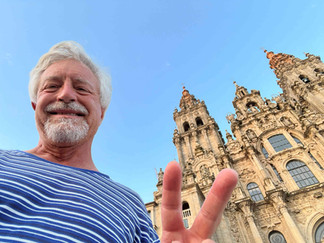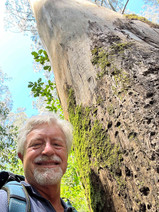I hope you are wondering the reason for the post title. Well, Gran Bazán produces great Albariño wines, for sure, and I have always enjoyed them. I also love the design of their labels. But the story goes the following way:
My dear Galician uncle Moncho Taboada Soto had just passed away in late 1995. Many of my relatives travelled from Madrid to Vilagarcía de Arousa for the wake but I was on business somewhere in Europe and could not make it. A couple of months later, Sally and I took my mother and our 11-month-old son, Ricky, to visit my aunt Maruja and cousin Juana María. That was a very special time full of meaning and connection. After the visits from many relatives and friends for the ceremonies the two had remained at home mourning rather lonely. Having Ricky with them was a joy that according to them helped them in the healing process. They always remind us that he began to take his first steps in their living room holding to the low table.
My uncle liked white wine and my aunt knew that I did too. She brought from their garage a case of Gran Bazán Etiqueta Ambar (Amber Label) and offered to drink it together at every dinner during our stay. I had had Gran Bazán Verde (Green Label) before but never the Amber one. From the very first glass of the first bottle, I realized I was confronted with a different wine from what I remembered. The legs were thicker and slower, there was more bouquet in there and the wine was more complex, with bakery aromas, and soothing in the throat.
Twenty-eight years later, in early July 2024 I had the opportunity to visit the winery. Ricky and I had just completed the last five stages of El Camino de Santiago and we were visiting my aunt and cousin. I sneaked out from their home and made a lightspeed visit to Gran Bazán.
The following are images of vineyards in the Valle del Salnés within the Rías Baixas denomination of origin, literally seconds and minutes from their home:
The vines are in some cases, just a few meters above sea level, exposed to marine breezes. The countryside is a puzzle of corn, eucalyptus, pine woods and vineyards. I am convinced that this vegetation, as well as the marine breeze have an influence in Rías Baixas Albariño’s flavors.
The following map shows the 5 Rías Baixas subregions, including Valle do Salnés:
Aside from the winegrowing focus I have inserted some pictures of this part of Galicia that my son Ricky and I took so that you can appreciate its beauty.
The prior week, before arriving to Valle do Salnés, we had been walking the last 5 stages of El Camino de Santiago. Let me offer some pictures below showing the fascinating journey:
Once at Gran Bazán I felt enamored by the beauty of their vineyards. Let me offer some samples in the following pictures:
The vines were elevated and supported in pergolas. That is not a common vine training method which has to be used in Rías Baixas because it is a very rainy region. The pergolas keep the leaves and fruits very high up far away from the ground to prevent rot and fungal infections. Even the posts are made of granite instead of wood. The harvesters pick the grapes from under the pergola with their arms reaching up. This is totally opposite to the back bending effort that has to be done at most vineyards worldwide. See below another example with a vineyard in pergola just beside a cemetery:
The winery is painted in light blue, the same color as the diagonal sash on the Galicia’s flag.

And the moment came to taste their wines. Come inside with me!
The enological tourism and public relations lead served me four of their wines. She commented that I had arrived one day before Tim Atkins who has become a fan of their wines. I learned that the vines were planted in 1980 using clones from several Rías Baixas locations. The parcels are managed individually to promote their unique expression and the musts are combined by the winemakers to produce the desired wine characteristics. As can be seen in the pictures, this is a Château type winery with the old building surrounded by the vineyards.
These were the four wines I tasted:

Gran Bazán Verde (Green Label): This is the most common of their wines and the one with the largest production. It is crafted with grapes from over 100 small growers from the Valle del Salnés. 100% Alvariño fermented in stainless steel and bottled after 4 months. A fresh and fruity example of what Rías Baixas has been offering all along. Mineral, I’d even say slightly salty, acidic and fresh, … very refreshing! Aromas of lime, green apple and eucalyptus. Light in mouth with very pleasant path down the throat.
Gran Bazán Ambar (Amber Label): This is the one that I enjoyed so much at my aunt’s home. The must is obtained by gravity and the wine is aged over its lees for a minimum of 8 months before bottling. This wine is more tempered than Verde – more dense and buttery – with primary aromas of jasmine, rockrose, fennel, Meyer lemon, cherimoya and tangerine, adding a secondary dimension that reminded of a bakery – bread dough, challah, … . In mouth, it was mineral, salty I would say, crisp and unctuous. The tangerine took over after a couple of sips. With the mouth’s heat some eucalyptus evaporated and ascended to the upper palate and larynx. The aftertaste was clean and soothing. Overall, this was a heavier weight and a more serious wine than Verde. Just before writing this post I tried it again in order to remove the allure of winery-tasting and finalize above tasting notes.
Don Alvaro de Bazán: This is a wine of extremely limited production and therefore I was very happy that I could try it. The grapes come from Gran Bazán’s own vineyards and it is aged a minimum of 2 years over its lees. This wine just tasted different and riper. It seemed to me as the elder more experienced wine looking after its younger peers. While still maintaining the acidity and saltiness proper of these wines, the aromas had evolved and reminded me more of mediterranean and tropical fruits. The body was unctuous and the aftertaste long while very soft. Given my almost full agreement with the aromas identified by the winery, let me paraphrase them here: Stone fruit, candied mango, quince and tangerine over a slightly herbal base that reminds of fennel, chamomile (certainly!) and green tea with subtle notes of leather (which I could not detect) and bee wax (which I felt). It was great to see the vineyards across the glass and know that the wine had come from them.

Gran Bazán Limousin: This wine is crafted with their best grapes. The production is very limited. Its main difference with the other wines is that part of its fermentation and aging was performed in French oak barrels. That gave it an entirely different dimension with the appearance of tertiary aromas such as vanilla and custard caramel. The aroma reminded me powerfully of Sally’s and my fruit garden. We have a pear tree, a peach tree, several fig trees and a loquat. I was very happy when the winery person shared with me those aromas. The wine had more weight than the others and it remained for a longer time in my throat. Comparing with the Loire Valley, while all the prior wines took me to Muscadet, with this one I could see myself at Vouvray. On the other hand, this wine was so different from my image of Rías Baixas and Albariño that to this day I am still deciding whether I prefer it to the non-oaked lighter fresher versions. At the end of the day the food pairing will decide.
By the way, let me make a digression and explain what Limousin means. During the Napoleonic wars England inflicted serious damage to the French navy and was finally able to establish a continental blockade that was fundamental in promoting the French defeat. The French reacted by planting huge oak tree forest so that they would be able to rebuild their fleet. That was long-term thinking! The names of these forests are Allier, Nevers, Vosges, Bertranges and Limousin, this one from near Limoges in Central France. Nowadays those woods are used for a "tastier" end: Wine aging. French oak is subtler than American oak and provides flavors including vanilla, honey and nuts.
In addition to the tasting notes let me add this picture of the back labels. I loved them! They contain a lot of relevant information including the certifications, lot number, bar code and QR code. What that tells me is that Gran Bazán wines have traceability and this is a sign of quality assurance and control. KUDOS!

In summary, I’d say that if you plan to visit the Rías Baixas denomination Gran Bazán should be one of your top choices. The setting is beautiful, the facilities are tastefully and functionally decorated and the wines are excellent providing the opportunity to taste a variety of styles always faithful to their varietal, terroir and culture.
I have seen a few bottles of Gran Bazán Verde Magnum at the PA liquor stores of Center Ave., Northern Pike and The Waterfront in Pittsburgh but they might have been purchased. It is available for shipping at www.finewineandgoodspirits.com
Contact information for Gran Bazán:
AGRO DE GRANBAZAN S.A.
Calle Tremoedo 46
Vilanova de Arousa 36628
Pontevedra, Spain
Phone: +34 619 118 381
In your honor Tía Maruja, Tío Moncho, Prima Juana María and my son Ricky!



















































































































Very nice story. I love the personal touch and the descriptions of the wine and also the beautiful countryside. Thank you!!
I see several Albariño wines listed at finewineandgoodspirits.com. There is one by Gran Bazán but not available near me. I will see if I can try one or two of the others.
Wonderful post, and hugely informative…☺️
Thank you ..
¡Gracias por compartir tu historia desde un lugar maravilloso!
Ricardo,
This is so beautifully written and the descriptions are so vivid that I swear I can taste the wine without even putting a glass to my mouth! I can’t wait to taste the real thing. I can imagine what a wonderful experience it will be.
Thank you for this wonderful story of love, devotion, and sharing the commitment of your family to create something delicious and beautiful.
Thanks for the excellent report on these beloved albariños and the lovely background info and photos.